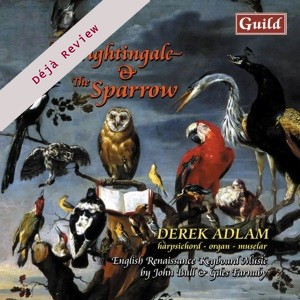
Déjà Review: this review was first published in February 2003 and the recording is still available.
The Nightingale and the Sparrow
Derek Adlam (harpsichord, organ, muselar)
rec. 2001, Priory Church of Our Lady and St Cuthbert, Worksop, England
Guild GMCD7233 [78]
The English renaissance is fairly well-trodden ground for recordings these days, but it was an era of such tremendous fecundity that there is still much of interest to be explored. Strangely, it is the secular music that has perhaps been less recorded than the sacred choral repertoire. Of the keyboard music of that great era, collections such as the famous Fitzwilliam Virginal Book or the huge Byrd collection in My Ladye Neville’s Book have become well known. This interesting disc by Derek Adlam explores some of the major keyboard works of two composers whose reputation has not become quite so great as that of the Byrds or the Dowlands. John Bull and Giles Farnaby are, however, probably the most innovative of the keyboard composers of their time. Both specialist composers of keyboard music they managed to extend the existing genres of their era and explore domestic keyboard music in all its guises without ever loosing the sense of spectacle which makes this repertoire so enjoyable to listen to. John Bull, in particular, is a composer well worth exploration, and this disc starts with what must rate as one of the most remarkable keyboard compositions before the time of Bach – Bull’s giant fantasy variations on the popular tune As I went to Walsingham. This little ditty was quite frequently used as a keyboard model, but never to the extent that Bull manages. Adlam takes nearly 20 minutes at no sluggish tempo to perform this masterpiece. In it, Bull contrives to subject his material to every possible ornamental device using the practice of division writing; replacing slower moving note values with strings of ever shorter notes. The technical skill is undeniable, but the arrangement of the 30 variations provides a large scale formal structure of great grandeur. Adlam’s pacing and sense of the unfolding of the architecture is very convincing.
The other large scale works of John Bull are better known; the Fantasy on Ut re me fa sol la uses a simple scale as the main musical material while the In Nomine IX uses a fragment of plainsong from the Benedictus section of a mass by Taverner. This work is written in the odd time of 11/4 – an irregularity which, combined with the dazzling technical writing, makes the work hugely enjoyable. These are performed on stringed instruments from Derek Adlam’s own workshop, tuned in expressive unequal temperaments. This does give an unsettling effect when first heard; there is a sense of parts being simply ‘out of tune’ and yet it must be understood that this variation in tuning is all part of the colourful world of this repertoire which we loose if we render everything into the equal temperament of the modern piano. Tracks 2-4 use a small organ, of the type that would have accompanied the choir in a large church, for performance of another Bull In Nomine and a Salvator Mundi, the type of music that could have filled parts of the service in church as well as being suitable for domestic use. The organ is tuned in a different temperament to the harpsichord creating a somewhat uncomfortable shift between tracks 1 and 2, but the ear soon acclimatises to the different flavour.
Giles Farnaby was the same age as Bull, but his training and career were very different. He was largely self-taught as a musician, being a joiner by trade. It is possible that he was a builder of keyboard instruments. He may have been a pupil of Bull at some stage, and is probably no coincidence that Farnaby was admitted Bachelor of Music in the University of Oxford the same day in 1592 that Bull became Doctor of Music in the same university. Derek Adlam’s booklet notes speak in slightly disparaging vein about the talent of Farnaby, alleging that his “skill as a composer is limited, and his technical gifts slight” but then declares that “his variations on the tune Woody-cock are one of the best of all sets of English keyboard variations…” Farnaby’s output may have been less than that of Bull or Byrd, but to criticise him for not sounding like either of those masters seems strange. Indeed, Adlam’s performance of the Woody-cock variations shows no sign of his not being convinced of Farnaby’s gifts. There is a broad nobility in the pace and a generous shaping of the phrases and cadences that allows the essential grandeur of the simple tune to come across. Similarly the virtuoso performances of Kempe’s Morris and The King’s Hunt employing a muselar virginals (an instrument with the strings plucked close to their ends, giving a characteristic flutey sound) with rattling metal hooks attached to the bass strings in the former, show the sense of verve that infuses a lot of Farnaby’s music. Obviously Adlam has spent many years with this repertoire and is well versed in the subtleties that bring out its more human side. It has often been suggested that it is humanity which is lacking from this technically demanding music, but in the hands of a sensitive performer with intimate knowledge of the instruments for which the music was written there is plenty to enjoy in this delicate, yet never lightweight, repertoire.
Peter Wells
Help us financially by purchasing from


Contents
John BULL (1562/3-1628)
Walsingham
Fantasy
In Nomine IV
Salvator Mundi II
Giles FARNABY (c1563-1640)
Fantasy
Woody-cock
John BULL
Fantasy on Ut re me fa sol la I
Giles FARNABY
Mal Sims
Muscadin or Kempe’s Morris
The King’s Hunt
John BULL
Chromatic Pavane (Queen Elizabeth’s)
Chromatic Galliard
Prelude to the In Nomine
In Nomine IX

















